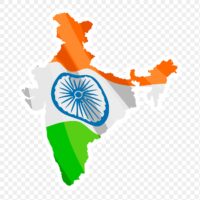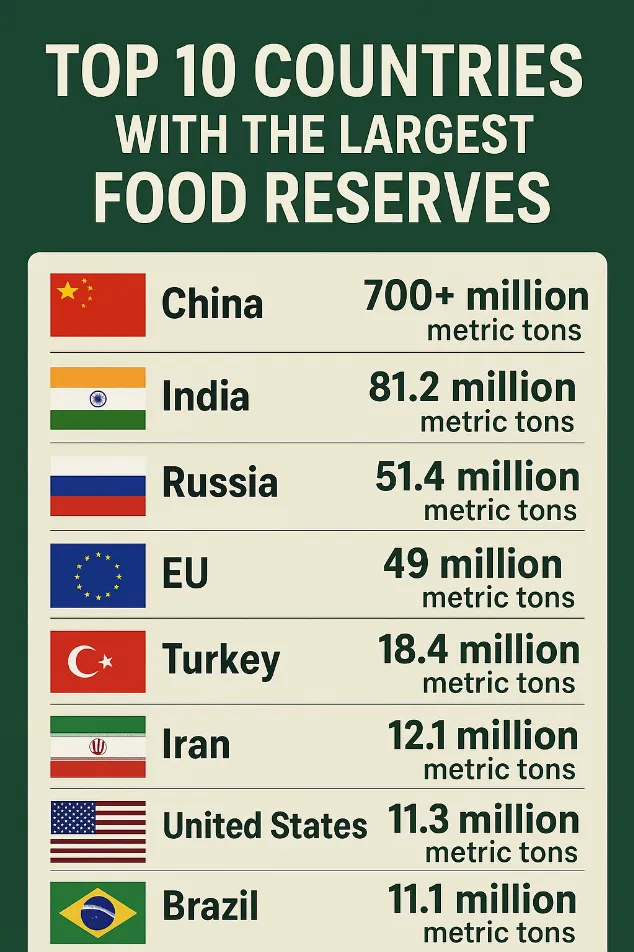1. China,s Food Reserves

China is by far the largest holder of food reserves in the world. Government data shows that its grain storage capacity has surpassed 700 million metric tons, which is roughly equal to its annual grain production. The reserves include rice, wheat, and corn, three staples of the Chinese diet.
China’s policy of “strategic food security” ensures that state agencies buy massive quantities of grain each year, filling government silos. In fact, international studies suggest China may hold more than half of the world’s publicly known grain stocks at any given time. These reserves provide a safety buffer for its population of 1.4 billion and act as a stabilizing factor in global food markets.
2. India,s Food Reserves

India is another agricultural giant and one of the top two food reserve holders in the world. The country’s Food Corporation of India (FCI) manages vast reserves of wheat and rice. As of September 2025, India held about 48 million metric tons of rice and 33 million tons of wheat in government storage facilities.
India’s reserves not only guarantee domestic food security but also support welfare programs such as the Public Distribution System, which supplies subsidized food grains to millions of low-income households. In addition, India uses its reserves for humanitarian exports and to stabilize domestic prices.
3. Russia,s Food Reserves

Russia has become a major player in global food security, especially in wheat. Apart from being the world’s largest wheat exporter, Russia also maintains large grain reserves. These reserves help protect its domestic market while also allowing it to influence international prices.
In recent years, Moscow has increased its storage capacity, using its reserves as both a strategic tool and a cushion against sanctions or global disruptions.
4. European Union (EU)

When considered collectively, the European Union is one of the largest holders of food reserves in the world. Member states like France, Germany, and Poland maintain significant storage facilities for wheat, corn, and barley. The EU uses these reserves to balance markets, support farmers, and ensure that its 450 million citizens are not affected by sudden shortages.
The EU’s food security strategy combines reserves with strong trade networks, making it one of the most resilient food blocs globally.
5. Turkey,s Food Reserves
Turkey has historically served as a food bridge between Asia and Europe. The country maintains substantial reserves of wheat and other grains to secure its domestic market. Ranked among the top countries for grain storage, Turkey uses its reserves both for internal consumption and as part of its growing influence in regional food trade.
6. Iran
Iran has steadily built up its food storage system to ensure independence during sanctions and geopolitical uncertainty. Reports place Iran at 7th in the world for grain reserves, with about 12 million metric tons. These reserves cover wheat, barley, and rice, providing a lifeline for its population during times of import restrictions.
7. United States
As one of the largest agricultural producers on Earth, the United States also holds vast reserves of wheat, corn, and soybeans. While some of these stocks are kept for commercial purposes rather than strategic reserves, the U.S. government maintains emergency supplies through programs managed by the Department of Agriculture.
America’s reserves serve a dual purpose: safeguarding domestic food security and providing aid during international crises.
8. Brazil
Brazil is famous for its soybeans, sugar, and corn production. While much of its harvest is exported, Brazil also maintains storage facilities to stabilize its domestic market. These reserves are particularly important during years of poor harvest or global price volatility.
Brazil’s position as a major agricultural exporter means that even moderate reserves give it significant leverage in the global food chain.
9. Canada
Canada has long been a global breadbasket, producing large surpluses of wheat and barley. Its reserves are built into a strong system of silos and grain elevators spread across the prairies. These reserves secure domestic demand while also ensuring Canada remains a steady exporter during times of global shortage.
10. Australia
Australia rounds out the list with its large reserves of wheat and barley. As a major grain exporter, Australia uses its storage system to balance exports and domestic needs. Its reserves act as a safeguard against droughts, which frequently affect the continent.
Why Food Reserves Matter
The importance of food reserves has grown sharply in recent years. Climate change, armed conflicts, and supply chain disruptions have highlighted the risks of depending too heavily on imports. Countries with strong reserves are more resilient to shocks, while those without may face hunger or inflation.
- China and India dominate global reserves, together holding more than half of the world’s stored grain.
- Russia, the EU, and the United States act as major stabilizers in world markets.
- Countries like Iran and Turkey show how reserves can be used for geopolitical independence.
Conclusion
Food reserves are more than warehouses full of grain—they are a symbol of national security. The countries listed above invest heavily in maintaining these stocks, ensuring that their citizens remain protected even in the worst crises. As the world faces increasing uncertainty, nations that prioritize food storage will remain in the strongest position to protect their people and influence global markets.
- iPhone 17 Pro Max Launch Date: 10 Reasons to Wait for iPhone 17 Series
- Green Vegetables Benefits – हरी सब्ज़ी खाने से होने वाले 10 बड़े फायदे
- क्या BRICS देश मिलकर अपनी मुद्रा बना सकते है?
- QUAD की बैठक; India-America की तनातनी के बीच क्या रद्द होगी ?
- JPG to PNG to WEBP converter
- Convert Any File Into PDF
- Facts About Tomatoes That You May Not Know
- Age Calculator
- Rashii Khanna: Biography, Career, Movies, Awards and Unknown Facts
- Vicky Kaushal & Katrina Kaif Announce Pregnancy: A New Chapter Begins
